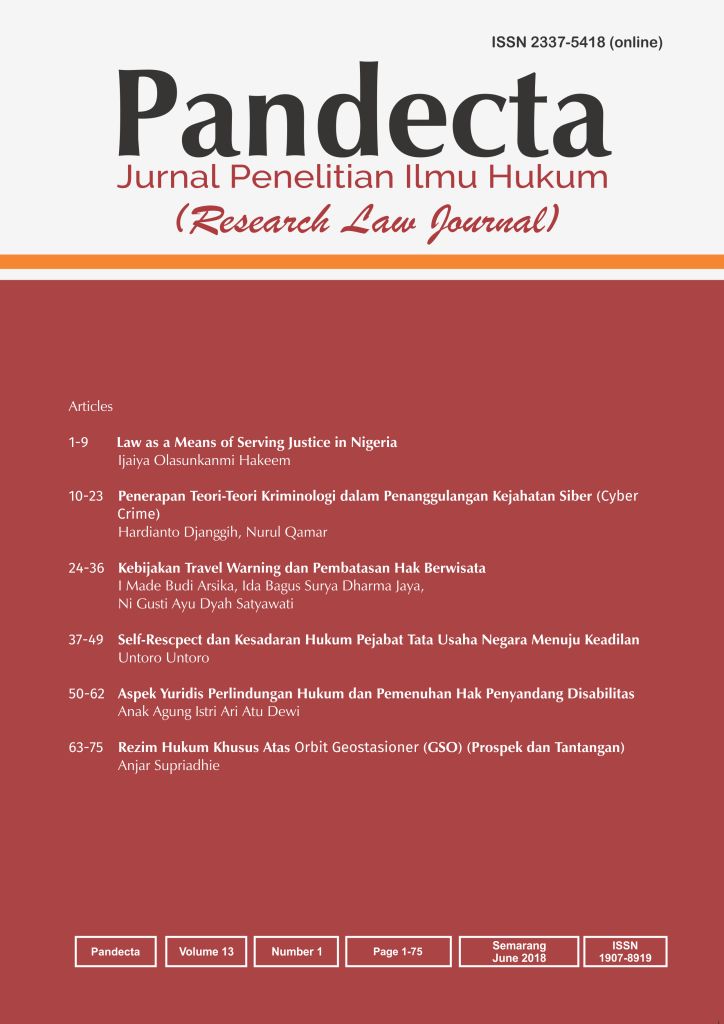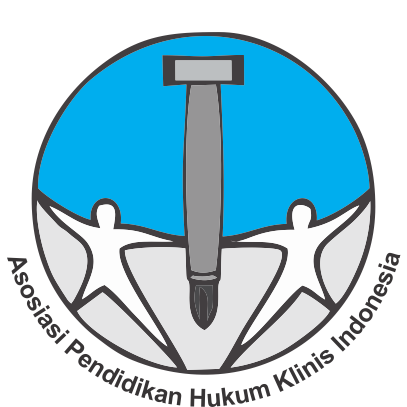Penyelesaian Sengketa Bisnis dalam Kerangka Belt and Road Initiative
(1) Universitas Tanjungpura
(2) Universitas Tanjungpura
Abstract
Inisiatif kejasama internasional yang diinisiasi oleh Negara Cina yang disebut Belt and Road Initiative (BRI) dikembangkan untuk mewujudkan integrasi ekonomi wilayah Eurasia. Kerjasama ini pada akhirnya memunculkan hubungan hukum yang kompleks antara berbagai entitas baik pada tataran publik maupun privat. Dalam taraf privat, kerjasama maupun proyek yang melibatkan pihak yang berasal dari berbagai kewarganegaraan serta bidang sengketa yang beragam dalam kerangka BRI akan memberikan permasalahan tersendiri. Artikel ini bertujuan untuk mengkaji aspek penyelesaian sengketa khusus dalam bidang bisnis pada kerangka BRI. Mengingat luasnya ruang lingkup permasalahan hukum yang terkait dengan BRI maka pembahasan akan dibatasi agar lebih fokus yakni menganalisa kerjasama BRI dari konteks penyelesaian sengketa. Ditemukan terdapat beberapa pilihan penyelesaian sengketa yang dapat dipilih oleh para pihak yang terlibat dalam Proyek BRI yakni Bentuk Alternatif Penyelesaian Sengketa yang bersifat non-adjudikatif seperti negosiasi maupun mediasi, pengadilan nasional, China’s International Commercial Courts (CICC), forum arbitrase nasional, arbitrase internasional. Indonesia merupakan negara mitra yang penting dalam implementasi BRI. Untuk itu, Indonesia perlu memperhatikan sumber hukum internasional yang mendukung proses penyelesaian sengketa yang bersifat transnasional.
International cooperation initiated by China called the Belt and Road Initiative (BRI) was developed to realize economic integration from Eurasia. The implementation of this initiative includes cooperation in strategic areas that are very comprehensive. This cooperation ultimately gave rise to complex legal relationships between various entities at both the public and private levels. At the private level, collaborations and projects involving parties of various nationalities as well as various dispute areas within the BRI framework will present significant issues. This article aims to examine aspects of dispute resolution specific to the business sector under the BRI framework. It was found that there are several dispute resolution options that can be chosen by the parties involved in the BRI Project, namely non-adjudicative alternative forms of dispute resolution such as negotiation or mediation, national courts, China's International Commercial Courts (CICC), national arbitration forums, international arbitration. Indonesia is an important partner country in the implementation of BRI. For this reason, Indonesia needs to pay attention to international legal sources that support transnational dispute resolution processes.
Keywords
Full Text:
PDFReferences
Fang Jin. (2017). The Belt and Road Initiative: Progress, Problems and Prospects, dalam Parallel Perspectives on the Global Economic Order, A Report of the CSIS Simon Chair in Political Economy and the Shanghai Institutes for International Studies
World Bank Group. (2019) Belt and Road Economics: Opportunities and Risks of Transport Corridors. Washington: the World Bank
Office of the Leading Group for Promoting the Belt and Road Initiative. (2019). The Belt and Road Initiative: Progress, Contributions and Prospects. Beijing: Foreign Languages Press Co. Ltd.
Alison Goh. (2021). Framework for the Resolution of Disputes Under the Belt and Road Initiative. Arbitration: The International Journal of Arbitration, Mediation and Dispute Management Vol. 87 (2)
Wang, J. (2020). Dispute Settlement in the Belt and Road Initiative: Progress, Issues, and Future Research Agenda, The Chinese Journal of Comparative Law, Vol. 8 No. 1. pp. 428. doi:10.1093/cjcl/cxaa016
Guiguo Wang. (2017). The Belt and Road Initiative in Quest for a Dispute Resolution Mechanism. Asia Pacific L Rev 25(1)
Garlick, Jeremy. (2020). The Regional Impacts of China’s Belt and Road Initiative. Journal of Current Chinese Affairs Vol 49 (1)
Huala Adolf. (2016). Urgensi Pembentukan Undang-Undang Tentang Arbitrase Internasional. Fiat Justisia, Volume 10 Issue 2, April-June 2016 pp 221-412
James Roger and others. (2018). Belt and Road Initiative Disputes: Bumps in the Road. 11 International Arbitration Report 23
Fatma Muthia Kinanti. 2015. World Trade Organization, Negara Berkembang dan Special and Diferrential Treatment. Pandecta Vol 10 (1)
Malik R. Dahlan. 2020. Envisioning Foundations for the Law of the Belt and Road Initiative: Rule of Law and Dispute Resolution Challenges. Harvard International Law Journal Essay VOL. 62.
Malik R Dahlan. (2019). Dispute Regulation in the Institutional Development of the Asian Infrastructure Investment Bank: Establishing a Normative Legal Implications of the Belt and Road Initiative. AIIB Yearbook of International Law 2019: International Organizations and the Promotion of Effective Dispute Resolution, p. 121 – 129
Martin David and others. (2019). BRI Risk Mitigation and Dispute Resolution Options in the Coming Decade. Asian Legal Business, December 2019.
Md Nazirul Islam Sarker and others. (2018). One Belt One Road Initiative of China: Implication for Future of Global Development. Modern Economy Vol 9.
Zachary Mollengarden. (2019). “One-Stop” Dispute Resolution On The Belt And Road: Toward An International Commercial Court With Chinese Characteristics. Pacific Basin Law Journal, 36(1)
Xiao Qian. (9 April 2019). Belt And Road Benefits Indonesia, The World, Jakarta Post.
IBA OBOR Subcommittee. (2019, Desember). Semi Annual Report. Diakses dari file:///C:/Users/ASUS/Downloads/IBA-OBOR-Subcommittee-Semi-Annual-Report-December-2019.pdf
Jean-Marc F. Blanchard (2018, February 2018). Revisiting the Resurrected Debate About Chinese Neocolonialism, Diakses dari https://thediplomat.com/2018/02/revisiting-the-resurrected-debate-about-chinese-neocolonialism/.
Green BRI Center. (January, 2021). The Countries of Belt and Road Initiative (BRI). Diakses dari https://green-bri.org/countries-of-the-belt-and-road-initiative-bri/.
Nedopil, Christoph. (2021). “Countries of the Belt and Road Initiative”. Diakses dari www.green-bri.org
Martin Raiser dan Michele Ruta. (2019, 20 Juni). Managing the risks of the Belt and Road, diakses dari https://blogs.worldbank.org/eastasiapacific/managing-the-risks-of-the-belt-and-road
Fung Business Intelligence Center. (Mei 2015). The Silk Road Economic Belt and the 21st Century Maritime Silk Road. Diambil dari: https://www.fbicgroup.com/sites/default/files/The%20Silk%20Road%20Economic%20Belt%20and%2021st%20Century%20Maritime%20Silk%20Road%20MAY%2015.pdf
[...]. (12 Mart 2021). List of countries that have signed cooperation documents with China to jointly build the “Belt and Road”, Belt and Road Portal, 12 Maret 2021, dapat diakses dari https://www.yidaiyilu.gov.cn/info/iList.jsp?tm_id=126&cat_id=10122&info_id=77298.
[...], About KCIC, dapat diakses pada: https://kcic.co.id/en/tentang-kami/profil/
Meng Yu. (21 Mei 2020). List of China's Bilateral Treaties on Judicial Assistance in Civil and Commercial Matters (Enforcement of Foreign Judgments Included), China Justice Observer. dapat diakses pada: https://www.chinajusticeobserver.com/a/list-of-chinas-bilateral-treaties-on-judicial-assistance-in-civil-and-commercial-matters,
Havd Vebri. (9 Juli 2019). Sengketa bisnis yang melibatkan perusahaan asing dan perusahaan lokal makin marak. Kontan. diakses pada: https://nasional.kontan.co.id/news/sengketa-bisnis-yang-melibatkan-perusahaan-asing-dan-perusahaan-lokal-makin-marak.
[...], (8 Juli 2019). di Arbitrase Singapura Kasus Perusahaan Indonesia Terbanyak Kelima, wartaekonomi.co.id. Warta Ekonomi. dapat diakses pada: https://www.wartaekonomi.co.id/read235601/wow-di-arbitrase-singapura-kasus-perusahaan-indonesia-terbanyak-kelima, 8 Juli 2019, akses pada: 30 April 2021
MoU Between The Government Of The Italian Republic And The Government Of The People’s Republic Of China On Cooperation Within The Framework Of The Silk Road Economic Belt And The 21st Century Maritime Silk Road Initiative
‘Vision and Actions on Jointly Building Silk Road Economic Belt and 21st-Century Maritime Silk Road”, Part III: “Framework”’ People’s Republic of China National Development and Reform Commission, Ministry of Foreign Affairs, and Ministry of Commerce (28 March 2015)
Convention of 2 July 2019 on the Recognition and Enforcement of Foreign Judgments in Civil or Commercial Matters
UNCITRAL Model Law on International Commercial Arbitration 1958
United Nations Convention on International Settlement Agreements Resulting from Mediation 2018
Intermediate People's Court of Hangzhou Municipality, Zhejiang Province, Hyundai Heavy Industries Co., Ltd. and The Zhejiang Provincial Branch of the Industrial and Commercial Bank of China Limited, An Appeal Concerning a Dispute Over a Demand Under an Independent Guarantee, 2017
Intermediate People's Court of Nanjing Municipality, Jiangsu Province, B&R Typical Case 13 Kolmar Group AG, A Case of an Application for the Recognition and Enforcement of a Civil Judgment of the High Court of Singapore, 2017
High People’s Court of Jiangsu Province, Jiangsu Taihu Boiler Co., Ltd. and PT. Krakatau Engineering Corporation as well as the Wuxi Branch of Bank of China Limited, A Dispute over Fraud with a Guarantee, 2015
Intermediate People’s Court of Ningbo Municipality, Zhejiang Province, Zhe Jiang Yisheng Petrochemical Co., Ltd. v. INVISTA Technologies S.à.r.l., Luxembourg, A Case of an Application to Affirm the Invalidity of an Arbitration Clause (2014), 2015
Refbacks
- There are currently no refbacks.


